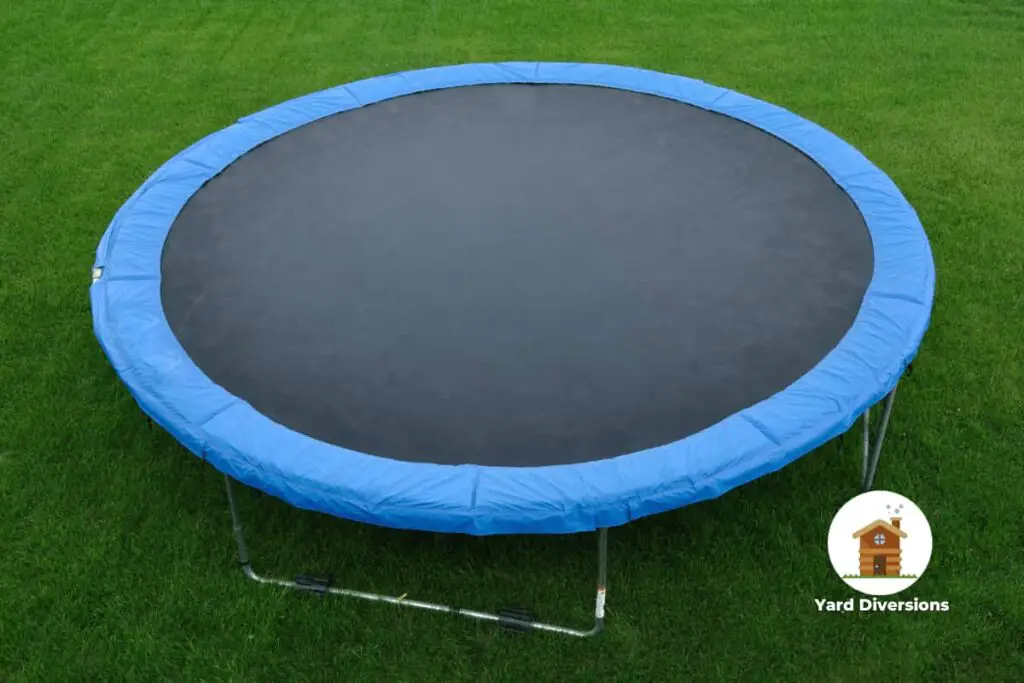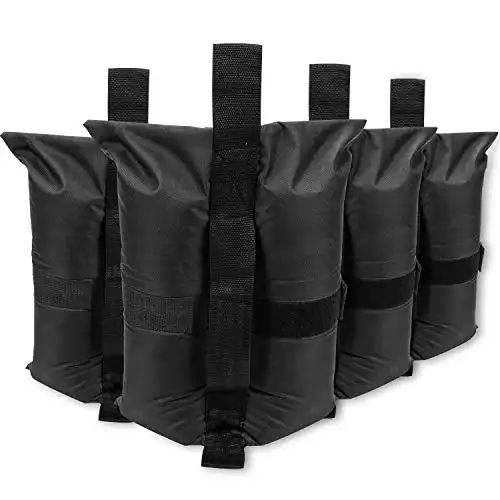Trampolines are a great source of outdoor entertainment for children and adults alike. However, setting up a trampoline on a concrete surface can pose some risks when you don’t have a lawn or soft ground space.
Landing on a hard surface can be discomforting and cause injuries. It is, therefore, essential to set up proper landing material under the trampoline to cushion falls and reduce the impact.
n this blog post, we’ll explore what to put under a trampoline on concrete so that you and your loved ones can jump confidently and safely.

The Importance of Choosing the Right Surface for Your Trampoline
When it comes to trampoline safety, choosing a suitable surface should be a top priority.
Grass is the ideal surface as it provides a soft landing and allows the legs of the trampoline to sink in slightly.
However, if you are placing your trampoline on concrete, you must take extra precautions to ensure safety.
Concrete surfaces can damage the trampoline frame and pose a risk to those jumping on it.
Therefore, it’s important to explore options like sandbags for anchoring, soft bases for preventing damage, and synthetic grass mats or rubber matting for a secure surface.
It’s important to research and consider all factors before placing your trampoline on hard surfaces to ensure safety and longevity.
How Concrete Can Affect Your Trampoline
When it comes to placing your trampoline on concrete, it’s important to consider how the concrete can affect your equipment.
Since concrete is a hard surface, it lacks any shock-absorbing properties, which can cause damage to your trampoline over time.
Bouncing into the hard ground repeatedly can cause the trampoline frame to bend and warp. This can potentially lead to safety issues and even void the warranty on your trampoline.
Investing in an extra layer under your trampoline is best to soften the impact and reduce the risk of damage. Keep reading to discover some great options for placing your trampoline on concrete.

Best Options for Placing Your Trampoline on Concrete
When it comes to placing your trampoline on concrete, a few options are available that will help protect both your trampoline and the surface below.
One solution is to use heavy objects like sandbags, which can be draped over the legs of the trampoline to hold it down securely.
Another option is to use rubber mats that are designed to absorb the impact of the trampoline’s use, helping prevent damage to both the trampoline and the concrete.
Synthetic grass mats can also be a great choice, providing a soft and plush area for your trampoline to rest on.
Ultimately, it’s essential to consider factors like safety, durability, and cost when choosing the best option for your trampoline on concrete, so do your research before making your final decision.
Sandbags as a Secure Solution
Sandbags can be a secure solution when placing your trampoline on concrete or other hard surfaces.
Because it’s not always possible to use anchor kits or wind stakes, sandbags can add weight to your trampoline and prevent it from moving around or overturning.
Using four 25lb sandbags (like shown below) strapped onto or draped over each of the U-shaped frame legs is a good option.
Sandbags can also be used to secure a trampoline on a deck or on sandy soil where stakes or anchors may not work.
While other options are available for securing a trampoline, sandbags are a simple and cost-effective solution that can really make a difference.
Using Soft Bases to Prevent Damage
Another excellent option for preventing damage to your trampoline when placed on concrete is using soft bases. These bases can include foam, rubber padding, mulch, or landscaping fabric.
Placing a layer of these soft materials underneath your trampoline can significantly absorb the impact of any jumps or falls.
This not only helps to prevent damage to your trampoline but also reduces the risk of injury to anyone using it.
In addition, using a soft base can reduce noise and prevent the trampoline from sliding around on the concrete surface.
Incorporating a soft base is an effective and practical solution to protect your trampoline and promote safe play.
Synthetic Grass Mats: A Great Choice
When it comes to finding a soft and safe surface for a trampoline placed on concrete, synthetic grass mats make for a great choice.
Artificial grass mats’ plush and cushioned surface effectively absorbs shock and prevents damage to the trampoline’s frame.
Additionally, synthetic grass mats provide a visually pleasing and low-maintenance alternative to natural grass, which can quickly become worn and damaged when trampolines are placed on it.
Other soft base options, such as rubber matting, can offer similar shock absorption levels, but synthetic grass mats take the lead in terms of style and ease of maintenance.
When deciding how to place a trampoline on concrete, it’s essential to consider safety, durability, and aesthetics, making synthetic grass mats an innovative and practical choice.
Rubber Matting: The Ideal Surface
When it comes to placing your trampoline on concrete, rubber matting is one of the ideal surfaces for it.
Rubber matting not only provides excellent shock absorption but also protects your trampoline from scratches and damage that hard concrete can cause.
In addition, rubber matting is durable and weather-resistant, making it a great option for outdoor recreational activities.
It’s also easy to install and can be found at various suppliers, like Greatmats. However, it’s important to remember that placing a rubber mat alone is not enough to ensure your trampoline’s safety.
Adding additional safety measures, like securing the trampoline with anchors and a net, will ensure greater safety and longevity for your trampoline.
Other Material Options for Trampoline Placement
Aside from sandbags, synthetic grass mats, and rubber matting, you can consider other material options when placing your trampoline on concrete.
Some good choices include wood chips, pea gravel, or mulch. These materials create a soft, cushioned surface that can help absorb shocks and prevent injuries.
Another option is foam padding, which can be placed under your trampoline to provide extra protection against falls.
Ultimately, the choice of material will depend on your personal preferences and the level of protection you want for your trampoline.
Remember, it’s always important to research and choose the right surface for your trampoline to ensure both safety and longevity.
What Are the Best Ways to Protect Your Trampoline during Winter?
When winter arrives, storing your trampoline for winter is crucial to ensure its longevity and safety. Firstly, dismantle the trampoline, removing the mat, springs, and frame. Clean and dry each component thoroughly, then store them in a dry and covered location. Consider using a trampoline cover to shield it from harsh weather conditions. Regularly inspect the stored trampoline for any signs of damage or wear, maintaining it properly for the next bouncing season.
Factors to Consider When Placing Your Trampoline on Concrete
Before setting up your trampoline on a hard surface such as concrete, it’s important to consider a few factors to ensure the safety of those using it.
As mentioned earlier, using soft bases and mats are crucial to prevent damage and provide a cushioning effect.
Additionally, securing the trampoline to the ground with sandbags or stakes, especially in windy weather, is essential to avoid accidents.
It’s also important to make sure that the trampoline is placed on level ground as positioning it on a slope or an incline will increase the risk of injuries.
Remember to avoid unexpected accidents and keep any obstacles away from the area under the trampoline.
Lastly, always leave sufficient clearance space between the trampoline and any wall or fence.
Considering these factors, you can ensure a safe and enjoyable trampoline experience on concrete surfaces.
How Can Understanding the Parts of a Trampoline Help Protect It and Ensure Safety for Users?
Understanding trampoline parts breakdown is crucial for ensuring safety. Knowing the components such as the frame, springs, and jumping mat can help protect the trampoline from damage and prevent accidents. Regular inspection and maintenance of each part can significantly reduce the risk of accidents and prolong the trampoline’s lifespan.
Conclusion: Do Your Research Before Setting Up Your Trampoline on Hard Surfaces.
In conclusion, it’s crucial to do your research before setting up your trampoline on hard surfaces such as concrete.
As previously mentioned, placing a trampoline on a hard surface can be dangerous as there’s no give and could result in the trampoline being unable to absorb impact energy.
However, there are several solutions such as rubber matting, synthetic grass mats, and wood chips to help provide a soft base for your trampoline.
It’s vital to consider factors such as weather conditions, the size of your trampoline, and the weight it can hold before deciding on a solid support structure.
By doing so, you can ensure the safety of everyone who uses the trampoline and the trampoline itself.
Remember, safety should always be your top priority for outdoor activities.


